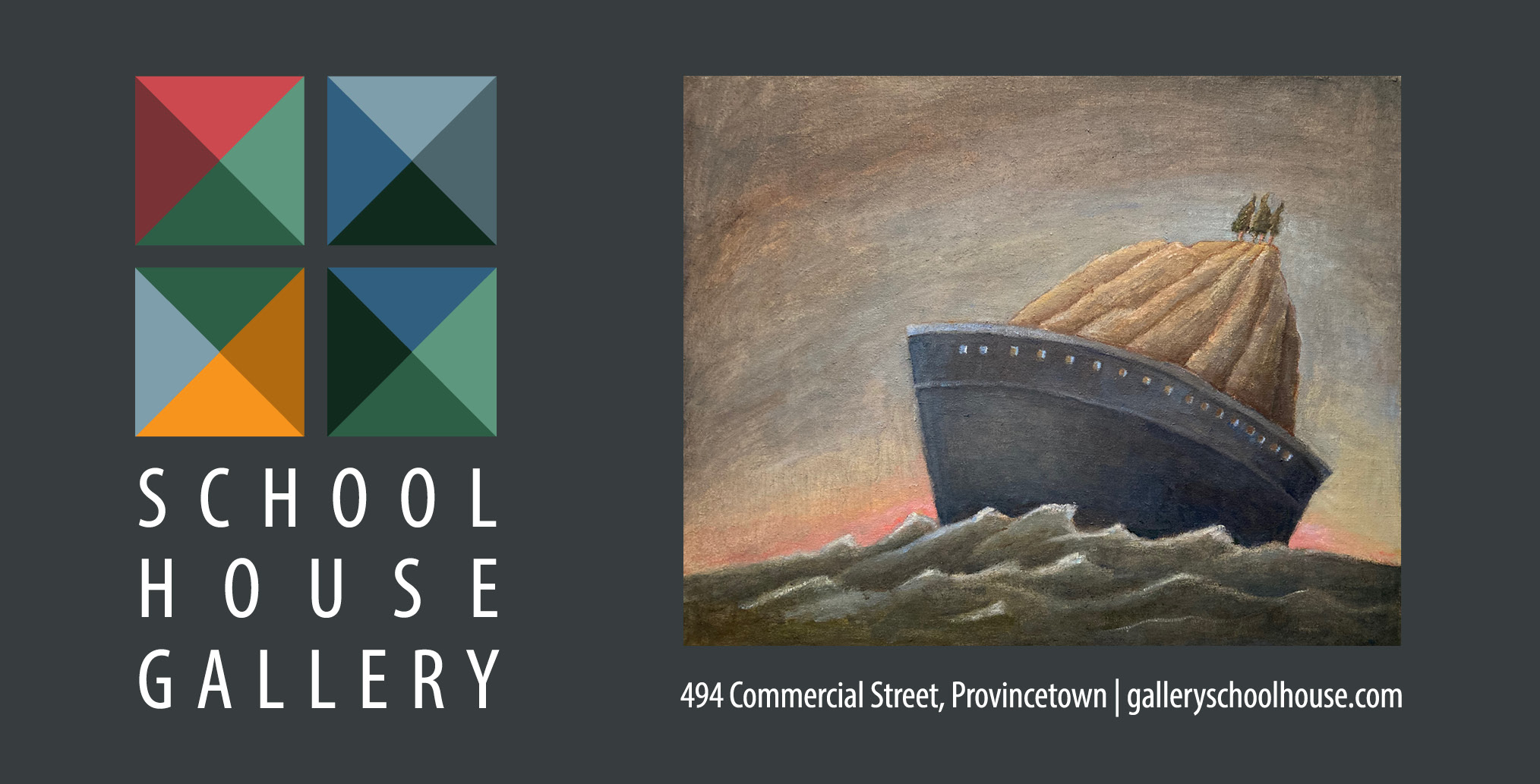The Outer Cape, weathered and romanced by the Atlantic and bathed in a certain extraordinary light, has long inspired visual artists. Their work is all around us. What would happen, cellist Joseph Gotoff says he wonders, if a concert of classical music was programmed to respond to that art?
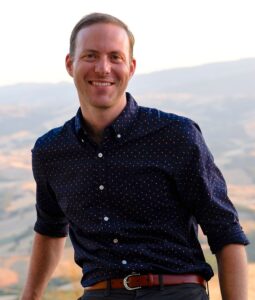
“The way we think about music and pull it apart is really much the same as how people talk about art,” he says. “What the artist was experiencing when they were painting; what the subliminal messages are.”
Gotoff is founder of the Outer Cape Chamber Music Festival, which will have its inaugural concert on Tuesday, June 24 in the main gallery of the Provincetown Art Association and Museum. A second concert will be on July 1. The aim of the festival, says Gotoff, is to program music that responds to the visual art in the museum, both in the permanent collection and in curated exhibitions.
On the program for the first concert are four chamber works for string quartet and soprano: singer Bridget Haile, violinists Ken Hamao and Yoonhee Lee, violist Samuel Kelder, and Gotoff on cello. Each piece shares “a sense of intimacy tinged with melancholy,” says Gotoff, that is also present in four works of art he’s chosen.
Gotoff was born in Boston but grew up in Lewisburg, Pa. His family has visited Truro in the summer since the 1950s. He says his path has been circuitous. He started on cello in elementary school. Planning to study medicine, he majored in biology at Princeton. But in his senior year, he decided to get a master’s degree at the Mannes College of Music before pursuing medicine further, and music won out.
Now Gotoff lives in Washington, D.C. and is assistant professor of strings at Towson University. He has played with the Cape Cod Chamber Orchestra for six years, and he’s been to PAAM many times, he says. “There are some pieces in their permanent collection that have always stood out to me.”
All of the pieces on Tuesday’s program are tone poems: works that illustrate texts. First is Samuel Barber’s “Dover Beach,” composed in 1931 to illustrate Matthew Arnold’s poem describing the moonlit, vast, and lonely cliffs of Dover in England.
“The sea is calm tonight,” the singer proclaims over the violins’ undulating dissonance. “The tide is full, the moon lies fair.” Arnold writes of the “grating roar” of pebbles tossed by the tide and the cold and uncaring “breath of the night wind.” The illusory world of the cliffs sounds “the eternal note of sadness,” Arnold writes. Barber’s piece is full of shadows.
Gotoff sees this music connecting with Charles Hawthorne’s His First Voyage, in which the expression of a young boy chills the warmth of a domestic scene. The boy’s impending voyage will likely put his life in danger, says Gotoff. There’s a similar tension, a feeling of unreality, apparent in Barber’s music, Arnold’s poem, and Hawthorne’s art.
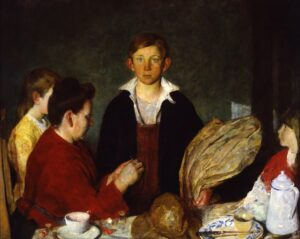
When it comes to classical music, “Many people don’t know what they’re listening for,” says Gotoff. “If you give them an image, it helps to inspire them.”
Ottorino Respighi’s “Il Tramonto” (“The Sunset”), composed in 1914, is next on the program. Respighi wrote it to illustrate Percy Shelley’s 1816 poem, which tells the story of two young lovers doomed to tragedy: after a night spent together, the young man dies in his lover’s arms. Shelley himself drowned at 29 when his boat sank in a storm.
In looking for works at PAAM to accompany this piece, Gotoff says, he was struck by Edwin Dickinson’s Evangeline. “It’s a haunting, mysterious work that shares the same sense of beautiful melancholy and mysterious narrative that permeates Respighi’s piece,” he says. In Dickinson’s work, a woman is seen through a fogged window, or “through a veil,” says Gotoff.
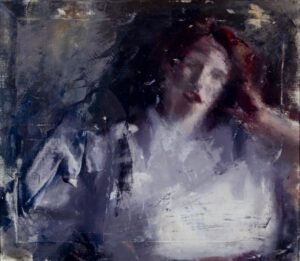
In programming American composer Arthur Shepherd’s “Triptych, for High Voice and String Quartet,” Gotoff says, he was thinking about PAAM’s upcoming exhibition of works by the artist Shirley Gorelick, beginning June 27.
In “Triptych,” Shepherd set texts from Bengali poet Rabindranath Tagore’s collection Gitanjali. The second movement of the piece illustrates the poem “The Day Is No More.”
“The day is no more,” the singer laments. “The shadow is upon the earth/ It is time that I go to the stream to fill my pitcher.”
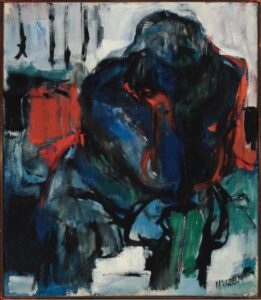
“It’s this incredibly simple, everyday moment that becomes profound through the artist’s attention,” says Gotoff. Gorelick’s work, he says, feels the same way. The human subjects of her paintings do ordinary things: they sit in chairs, they pose with arms crossed. It’s the attention of the artist that renders them striking. Of Shepherd and Gorelick, Gotoff says, “both are masters at taking intimate, personal moments and making them feel monumental.”
Last on the program is the world premiere of contemporary Boston composer Binna Kim’s “Lady Macbeth,” which she wrote for the festival: a setting of the sleepwalking scene from Shakespeare’s play, in which Lady Macbeth speaks the words “Out, damned spot!” Plagued by the smell and sight of blood, she descends into madness. Kim’s music is so rich with texture and rhythm that it gives the piece “a sense of psychological development,” says Gotoff.
Selina Trieff’s Untitled (Figure With Skeleton) shares “a banal sense of horror” with this music, says Gotoff. “Each subject is haunted by a demon that is unseen to them but obvious to the viewer.”
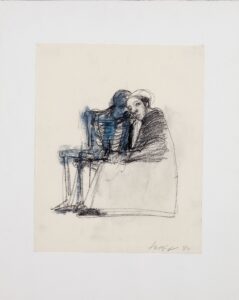
Attending a concert and going to an art museum are two very different experiences, Gotoff admits. Concerts draw crowds; standing in front of an artwork is often a solitary affair.
To be the sole listener in an empty concert hall would feel odd. “You actually want to be surrounded by people,” says Gotoff. As part of an audience, “our emotions are heightened by what other people are experiencing.”
Though the gallery where the concert will take place will be empty on the day of the concert, in preparation for an upcoming installation, the Hawthorne will be on display nearby in the Duffy Gallery and the Trieff and Dickinson in the Patrons Gallery.
Gotoff’s hope for the new festival, he says, is that the collective emotion felt while listening to the music will translate across mediums and electrify the experience of viewing art, even after the concert is over.
At a chamber music performance, the audience watches each musician in the process of creation. It’s almost like watching an artist paint — but far faster, and more fleeting.
“You’re seeing the performers create each note in real time,” says Gotoff. “You’re seeing the emotions cross over their faces while they’re playing. Nothing is by rote. You’re seeing a burst of creativity as it happens.”
Bridge Over Salty Water
The event: Outer Cape Chamber Music Festival inaugural concert
The time: Tuesday, June 24, 6:30 p.m.
The place: Provincetown Art Association and Museum, 460 Commercial St.
The cost: $30 at

